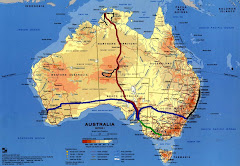The 6 km (loop) and 3-4 hour Kings Canyon Rim Walk traces the top of the canyon. A steep climb at the beginning of the walk, which locals call "Heartbreak Hill" (or "Heart Attack Hill", due to its steepness), takes visitors up to the top, with spectacular views of the gorge below and of the surrounding landscape.
See the person in the top left side of the photo? Gives you an impression of the size.
The stairs nearly killed me - they should call them the devil's staircase if they do not already do that anyway!


Wow - not more you can think about it!




Back in Alice Springs our 1500km journey which took us around the Red Canter of Australia came sadly to an end.

















































